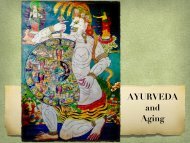How Thoreau's Walden Pond Mixed with the Ganges and Yoga Came to America with Swami Vivekananda
One early morning in 1846, during the coldest days of a New England winter, Henry David Thoreau looked out the window of his small cabin on Walden Pond and saw men cutting its ice into blocks. That ice was hauled by horse to a railroad that ran across the western edge of Walden Pond, packed into a boxcar, taken to Boston and loaded onto a clipper ship that sailed to Calcutta, India, arriving about four months later. Once there, that ice was purchased by grateful members of the East India Company. Thoreau had witnessed a small part of the global ice trade between New England and India that took place during the latter part of the nineteenth century. When Thoreau considered the ice trade, his vision sailed on metaphors far beyond the scope of business. The waters he imagined flowed both east and west and carried not just natural elements, but culture, religion and philosophy as well. He envisioned that after arriving in Calcutta, the New England ice of Walden Pond would eventually melt and run downhill where it would join with the sacred water of the Ganges. He wrote in Walden: "It appears that the sweltering inhabitants of Charleston and New Orleans, of Madras and Bombay and , drink at my well. In the morning I bathe my intellect in the stupendous and cosmogonal philosophy of the , since whose composition years of the gods have elapsed, and in comparison with which our modern world and its literature seem puny and trivial; and I doubt if that philosophy is not to be referred to a previous state of existence, so remote is its sublimity from our conceptions. I lay down the book [Bhagavad-Gita] and go to my well for water, and lo! there I meet the servant of the Bramin, priest of and and who still sits in his temple on the Ganges reading the , or dwells at the root of a tree with his crust and water jug. I meet his servant come to draw water for his master, and our buckets as it were grate together in the same well. The pure Walden water is mingled with the sacred water of the Ganges." This book tells the story of these waters . . .
One early morning in 1846, during the coldest days of a New England winter, Henry David Thoreau looked out the window of his small cabin on Walden Pond and saw men cutting its ice into blocks. That ice was hauled by horse to a railroad that ran across the western edge of Walden Pond, packed into a boxcar, taken to Boston and loaded onto a clipper ship that sailed to Calcutta, India, arriving about four months later. Once there, that ice was purchased by grateful members of the East India Company. Thoreau had witnessed a small part of the global ice trade between New England and India that took place during the latter part of the nineteenth century.
When Thoreau considered the ice trade, his vision sailed on metaphors far beyond the scope of business. The waters he imagined flowed both east and west and carried not just natural elements, but culture, religion and philosophy as well. He envisioned that after arriving in Calcutta, the New England ice of Walden Pond would eventually melt and run downhill where it would join with the sacred water of the Ganges. He wrote in Walden: "It appears that the sweltering inhabitants of Charleston and New Orleans, of Madras and Bombay and , drink at my well. In the morning I bathe my intellect in the stupendous and cosmogonal philosophy of the , since whose composition years of the gods have elapsed, and in comparison with which our modern world and its literature seem puny and trivial; and I doubt if that philosophy is not to be referred to a previous state of existence, so remote is its sublimity from our conceptions.
I lay down the book [Bhagavad-Gita] and go to my well for water, and lo! there I meet the servant of the Bramin, priest of and and who still sits in his temple on the Ganges reading the , or dwells at the root of a tree with his crust and water jug. I meet his servant come to draw water for his master, and our buckets as it were grate together in the same well. The pure Walden water is mingled with the sacred water of the Ganges."
This book tells the story of these waters . . .
Create successful ePaper yourself
Turn your PDF publications into a flip-book with our unique Google optimized e-Paper software.
New Engl<strong>and</strong> Ice Comes <strong>to</strong> India<br />
During <strong>the</strong> first half of <strong>the</strong> nineteenth century, India was not yet <strong>the</strong> Jewel<br />
in <strong>the</strong> Crown of <strong>the</strong> British Empire. The country was still a “business”<br />
directed by <strong>the</strong> East India Company, <strong>and</strong> although <strong>the</strong> Company made<br />
fantastic fortunes by its exploitation of <strong>the</strong> riches of India, a major problem<br />
confronted <strong>the</strong> British: oppressive tropical heat <strong>and</strong> diseases, which often<br />
involved fever. A joke going around those days was that Calcutta’s deadly heat<br />
was more dangerous <strong>to</strong> British life than any uprising by <strong>the</strong> natives. In 1774 an<br />
English surgeon wrote of his experience: "When not a breath of air was <strong>the</strong>re<br />
for many hours; man <strong>and</strong> every fowl of <strong>the</strong> air so sensibly felt it, that some<br />
species fell down dead."<br />
Tudor, ever <strong>the</strong> businessman, saw great potential in this. From experience,<br />
he knew that <strong>the</strong> extreme heat of India would make ice a precious commodity.<br />
He also believed that anyone, English or Indian, once <strong>the</strong>y had experienced<br />
<strong>the</strong> pleasure of iced drinks, iced cream or any chilled food, would become<br />
hooked on ice; <strong>and</strong> he planned <strong>to</strong> be <strong>the</strong> one <strong>to</strong> supply it.<br />
On September 5, 1833, Tudor's ship, <strong>the</strong> Tuscany, after sailing over a<br />
hundred miles up <strong>the</strong> Hooghly (<strong>Ganges</strong>) river from <strong>the</strong> Bay of Bengal,<br />
dropped anchor at Diamond Harbor in <strong>the</strong> port of Calcutta.<br />
Calcutta Harbor 1881<br />
!<br />
20


















